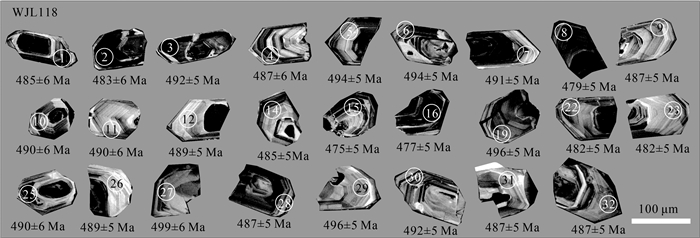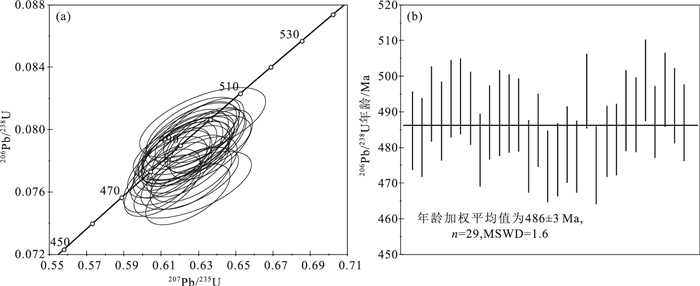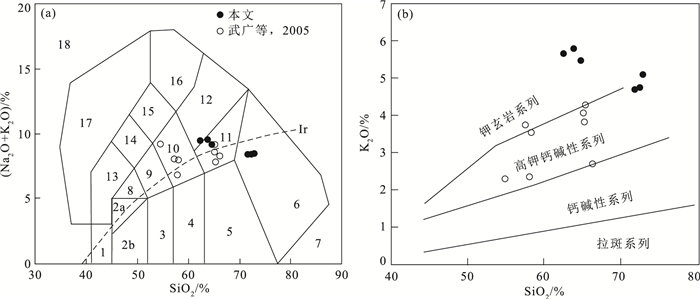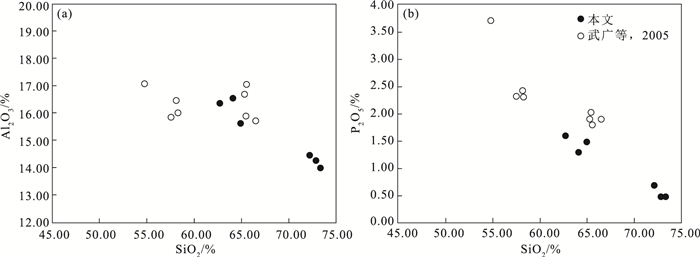Petrogenesis of Late Cambrian granite in Luoguhe district of the northern Great Xing'an Range and its constrain on the tectonic evolution of the Xing-Meng Orogenic Belt
-
摘要:
大兴安岭北段早古生代花岗岩主要分布于漠河—塔河一线。对漠河北部洛古河二长花岗岩开展岩石年代学与岩石地球化学研究。二长花岗岩中锆石为岩浆成因,LA-ICP-MS U-Pb测年表明,其形成时代为晚寒武世(486±3 Ma)。岩石具高硅(SiO2=62.75%~73.32%)、富碱(ALK=8.30%~9.45%)、高铝(Al2O3=13.97%~16.53%)、低镁、低钙和低钛的特点,铝饱和指数A/CNK为0.91~1.10,属偏铝质高钾钙碱性岩石系列。SiO2与Al2O3和P2O5具有较好的负相关性;富集Rb、Th、U、K、Zr、Hf等元素,而强烈亏损Ba、Nb、Ta、Sr、P、Ti等元素,球粒陨石标准化的稀土元素配分曲线图中呈轻稀土元素富集、重稀土元素亏损的右倾型配分模式,显示了Ⅰ型花岗岩特征。综合分析认为,洛古河岩体形成于西伯利亚板块南缘与额尔古纳等微陆块碰撞造山晚期由挤压体制向拉张体制转换的后碰撞构造环境。
Abstract:The Early Paleozoic granites in the northern part of the Great Xing'an Range are mainly distributed along the Mohe-Tahe.In this paper, geochronological and geochemical characteristics of the Luoguhe monzonite in the north of Mohe are studied.Zircons in the monzogranite is of magmatic origin, and LA-ICP-MS U-Pb dating indicates that it was formed in the Late Cambrian (486±3 Ma).The monzonite are characterized by high silicon (SiO2=62.75%~73.32%), rich alkali (AlK=8.30%~9.45%), high aluminum (Al2O3=13.97%~16.53%), low magnesium, low calcium and low titanium, with A/CNK value ranging from 0.91 to 1.10, indicating that monzonite belongs to aluminous and high potassium calc-alkaline rock series.The SiO2 content has a negative correlation with Al2O3 and P2O5.Rb, Th, U, K, Zr, Hf elements are enriched, while Ba, Nb, Ta, Sr, P and Ti are strongly depleted.In the chondrite normalized REE partition curves, LREE is enriched and HREE is depleted, which shows the characteristics of Ⅰ-type granites.Comprehensive analysis shows that the Luoguhe pluton was formed in a post-collisional tectonic setting during the late period of the orogeny between the southern margin of the Siberian plate and the Erguna micro landmass, which was transformed from compression system to extension system.
-

-
图 1 大兴安岭北部大地构造分区图(a)和洛古河地区地质简图(b)(图a据冯志强等, 2019, 许文良等, 2019;图b据周传芳等, 2021修改)
Figure 1.
图 5 漠河地区晚寒武世二长花岗岩TAS图解(a)(底图据Middlemost, 1994)和SiO2-K2O图解(b)(底图据Peccerillo et al., 1976)
Figure 5.
图 6 漠河地区晚寒武世二长花岗岩稀土元素球粒陨石标准化配分图(a)和微量元素原始地幔标准化蛛网图(b)(球粒陨石标准化值据Boynton, 1984, 原始地幔标准化值据Sun et al., 1989)
Figure 6.
图 8 漠河地区晚寒武世二长花岗岩成因类型及构造环境判别图解(图a~c底图据Pearce et al., 1984;图d底图据Batchelor et al., 1985)
Figure 8.
表 1 漠河地区晚寒武世二长花岗岩LA-ICP-MS锆石U-Th-Pb同位素分析测定结果
Table 1. LA-ICP-MS zircon U-Th-Pb isotopic dating of Late Cambrian monzonite in Mohe area
测点号 含量/10-6 Th/U 同位素比值 年龄/Ma Pb U 207Pb/206Pb 1σ 207Pb/235U 1σ 206Pb/238U 1σ 207Pb/206Pb 1σ 207Pb/235U 1σ 206Pb/238U 1σ 1 63 759 0.4702 0.0579 0.0008 0.6235 0.0096 0.0781 0.0009 526 29 492 8 485 6 2 150 1903 0.3478 0.0574 0.0007 0.6160 0.0087 0.0778 0.0009 509 26 487 7 483 6 3 100 1205 0.5142 0.0579 0.0007 0.6334 0.0088 0.0793 0.0009 526 26 498 7 492 5 4 73 894 0.4440 0.0574 0.0007 0.6214 0.0089 0.0785 0.0009 506 26 491 7 487 6 5 39 477 0.4439 0.0571 0.0008 0.6267 0.0103 0.0796 0.0009 496 31 494 8 494 5 6 60 723 0.4670 0.0572 0.0007 0.6286 0.0089 0.0797 0.0009 499 27 495 7 494 5 7 44 529 0.5219 0.0573 0.0009 0.6256 0.0106 0.0791 0.0008 504 34 493 8 491 5 8 55 696 0.4018 0.0578 0.0007 0.6153 0.0089 0.0772 0.0008 523 28 487 7 479 5 9 49 602 0.4582 0.0579 0.0007 0.6263 0.0088 0.0785 0.0008 525 27 494 7 487 5 10 38 466 0.3694 0.0571 0.0008 0.6218 0.0099 0.0789 0.0010 497 31 491 8 490 6 11 37 441 0.5023 0.0574 0.0008 0.6244 0.0101 0.0789 0.0009 507 32 493 8 490 6 12 33 410 0.3618 0.0575 0.0008 0.6249 0.0099 0.0788 0.0008 511 31 493 8 489 5 13 62 799 0.3391 0.0590 0.0007 0.6260 0.0089 0.0769 0.0008 569 26 494 7 478 5 14 81 1020 0.4156 0.0572 0.0007 0.6159 0.0083 0.0781 0.0008 499 26 487 7 485 5 15 72 910 0.4612 0.0580 0.0007 0.6108 0.0084 0.0764 0.0008 529 26 484 7 475 5 16 70 902 0.3773 0.0577 0.0007 0.6104 0.0085 0.0767 0.0008 518 26 484 7 477 5 17 33 421 0.3169 0.0588 0.0008 0.6277 0.0094 0.0774 0.0009 559 29 495 7 481 5 18 23 294 0.4108 0.0590 0.0009 0.6254 0.0107 0.0769 0.0008 567 34 493 8 477 5 19 59 716 0.5142 0.0574 0.0007 0.6329 0.0088 0.0799 0.0008 508 27 498 7 496 5 20 24 342 0.0628 0.0595 0.0010 0.6269 0.0129 0.0765 0.0009 584 38 494 10 475 5 21 39 515 0.2726 0.0597 0.0008 0.6243 0.0092 0.0759 0.0008 593 28 493 7 471 5 22 49 628 0.3550 0.0573 0.0007 0.6132 0.0087 0.0776 0.0008 504 28 486 7 482 5 23 50 630 0.3640 0.0583 0.0007 0.6243 0.0090 0.0777 0.0008 541 28 493 7 482 5 25 90 1027 0.8303 0.0584 0.0007 0.6368 0.0091 0.0790 0.0009 546 26 500 7 490 6 26 16 205 0.2837 0.0576 0.0011 0.6266 0.0129 0.0788 0.0008 516 42 494 10 489 5 27 22 282 0.3059 0.0570 0.0010 0.6322 0.0138 0.0804 0.0009 492 38 497 11 499 6 28 76 957 0.4114 0.0572 0.0007 0.6196 0.0083 0.0785 0.0008 501 26 490 7 487 5 29 44 555 0.3779 0.0569 0.0009 0.6272 0.0102 0.0800 0.0008 486 33 494 8 496 5 30 62 771 0.4031 0.0580 0.0007 0.6343 0.0087 0.0793 0.0009 531 26 499 7 492 5 31 27 346 0.3183 0.0575 0.0008 0.6223 0.0100 0.0785 0.0009 512 32 491 8 487 5 32 35 412 0.4161 0.0840 0.0012 0.9074 0.0137 0.0784 0.0008 1291 27 656 10 487 5 表 2 漠河地区晚寒武世二长花岗岩主量元素特征
Table 2. Major elements characteristics of Late Cambrian monzogranite in Mohe area
% 元素 WJL118花岗质初糜棱岩 WJL148二长花岗质初糜棱岩 WJL149花岗质初糜棱岩 WJL150二长花岗质初糜棱岩 WJL151花岗质糜棱岩 WJL180靡棱岩化中粒二长花岗岩 SiO2 62.75 73.32 72.87 64.97 64.07 72.18 Al2O3 16.34 13.97 14.26 15.62 16.53 14.44 TiO2 0.59 0.23 0.24 0.53 0.51 0.25 Fe2O3 2.10 0.59 0.68 1.67 1.64 0.56 FeO 4.15 1.22 1.25 3.62 3.62 1.51 CaO 2.76 1.08 1.09 2.83 2.46 1.17 MgO 0.62 0.37 0.41 0.54 0.55 0.57 K2O 5.63 5.09 4.73 5.46 5.78 4.69 Na2O 3.73 3.32 3.57 3.66 3.67 3.63 MnO 0.11 0.03 0.03 0.09 0.09 0.04 P2O5 0.16 0.05 0.05 0.15 0.13 0.07 灼失量 0.85 0.66 0.74 0.67 0.75 0.82 总和 99.78 99.92 99.92 99.80 99.80 99.92 K2O+Na2O 9.36 8.41 8.30 9.12 9.45 8.31 K2O/Na2O 1.51 1.53 1.33 1.49 1.57 1.29 TFeO 6.04 1.75 1.86 5.12 5.10 2.02 Mg# 17.71 30.72 31.61 18.11 18.44 37.18 A/CNK 0.95 1.08 1.10 0.91 0.99 1.10 σ 0.95 0.55 0.56 0.83 0.90 0.57 注:A/CNK=(Al2O3)/(CaO+K2O+Na2O),摩尔数比;Mg#=100*Mg2+/(Mg2++Fe2++Fe3+),离子摩尔数;σ=(Na2O+K2O)×2/(SiO2-43),质量分数 表 3 漠河地区晚寒武世二长花岗岩稀土和微量元素特征
Table 3. Chemical characteristics of rare earth elements and trace elements from Late Cambrian monzogranite in Mohe area
10-6 样品号 Y La Ce Pr Nd Sm Eu Gd Tb Dy Ho Er WJL118 57.82 80.22 179.08 21.54 84.14 15.60 2.81 13.90 2.26 12.72 2.38 6.85 WJL148 28.10 50.94 102.96 13.11 49.09 8.94 0.85 7.24 1.08 5.59 0.99 2.88 WJL149 21.46 34.56 78.95 9.19 35.62 6.58 0.75 5.48 0.84 4.54 0.84 2.30 WJL150 56.98 80.21 169.14 20.77 79.78 14.45 2.58 12.54 1.95 11.28 2.09 6.11 WJL151 58.33 98.58 205.64 23.23 94.31 16.35 2.48 14.12 2.19 11.95 2.23 6.21 WJL180 36.05 23.58 75.59 6.30 25.48 5.67 0.49 5.14 1.00 6.71 1.41 4.17 样品号 Tm Yb Lu δEu ΣREE (La/Yb)N LREE/HREE Li Sc Ga Rb Sr WJL118 1.24 7.23 1.04 0.58 488.61 7.96 3.64 93.75 17.79 26.22 169.95 142.20 WJL148 0.50 2.94 0.43 0.32 275.64 12.42 4.54 43.50 3.79 20.44 150.98 129.96 WJL149 0.42 2.47 0.37 0.38 204.38 10.05 4.27 50.60 2.67 19.53 120.03 114.64 WJL150 1.12 6.43 0.95 0.59 466.33 8.95 3.69 39.61 18.41 25.79 167.16 159.22 WJL151 1.12 6.33 0.92 0.50 544.28 11.17 4.26 63.17 12.90 26.50 168.53 154.52 WJL180 0.79 4.54 0.60 0.28 197.52 3.73 2.27 90.14 3.64 23.59 221.90 105.79 样品号 Zr Nb Ba Hf Ni Cr V Ta Th U Ag 10000Ga/Al WJL118 596.09 18.94 962.70 15.45 1.80 2.71 12.70 1.22 21.07 4.13 0.04 3.03 WJL148 203.87 9.46 401.35 6.52 2.88 3.64 11.27 0.45 24.44 3.06 0.02 2.76 WJL149 186.32 9.37 337.48 6.33 3.49 4.01 9.57 0.52 19.08 3.46 0.02 2.58 WJL150 609.89 18.09 966.97 14.50 1.86 3.56 12.61 0.90 19.04 2.51 0.05 3.12 WJL151 580.33 18.29 909.98 14.04 5.38 5.16 13.67 1.01 24.62 3.95 0.03 3.03 WJL180 174.78 15.89 320.86 6.00 4.07 5.56 13.27 1.92 26.17 5.92 0.05 3.09 注:δEu=EuN/[(GdN+SmN)/2] 表 4 大兴安岭北段漠河—塔河地区早古生代花岗岩特征
Table 4. Characteristics of Early Paleozoic granite for Mohe-Tahe district in Northern Great Xing'an Range
采样位置 岩性 测年方法 年龄/Ma 大地构造环境 资料来源 塔河地区 瓦拉干火山岩 玄武安山区 LA-ICP-MS 501.1±1.4 后碰撞造山环境 汪岩等, 2017 粗面玄武岩 500.5±0.95 壮志林场 花岗岩 LA-ICP-MS 488.9±2.6 后造山环境 杜兵盈等, 2019 塔河杂岩体 碱长花岗岩 LA-ICP-MS 492±5 后造山背景 葛文春等, 2005 正长花岗岩 494±9 正长花岗岩 485±6 辉长岩 490±3 二长花岗岩 485±3 永庆林场
(十八站岩体)斑状二长花岗岩 LA-ICP-MS 499±1 后造山或碰撞后造山环境 葛文春等, 2007 韩家园子南
(内河岩体)角闪花岗闪长岩 500±1 查拉班河 黑云母二长花岗岩 LA-ICP-MS 481±3 黑云母花岗闪长岩 475 ±2 465±1 白银纳西 黑云母花岗闪长岩 LA-ICP-MS 460±1 哈拉巴奇 二长花岗岩 LA-ICP-MS 500±2 后造山环境 隋振民等, 2006 黑云母花岗闪长岩 461±2 十八站-韩家园 二长闪长岩 LA-ICP-MS 512.4±3.5 活动大陆边缘/岛弧环境 柴明春等, 2018 漠河地区 漠河市西门都里 二长花岗岩 LA-ICP-MS 502.1±6.5 秦秀峰等, 2007 漠河漠北公路 黑云母二长花岗岩
(A型花岗岩)481±5 造山后伸展环境 吴琼等, 2019 漠河富源沟岩体 含电气石花岗岩
(S型花岗岩)458±4 同碰撞构造背景 段明新等, 2019 洛古河
(洛古河岩体)二长花岗岩 SHRIMP 504±8 后碰撞造山环境 武广等, 2005 石英闪长岩 517±9 -
[1] Badarch G, Cunningham W D, Windley B F. A new terrane subdivision for Mongolia: Implications for the Phanerozoic crustal growth of Central Asia[J]. Journal of Asian Earth Sciences, 2002, 21(1): 87-110. doi: 10.1016/S1367-9120(02)00017-2
[2] Batchelor R A, Bowden P. Petrogenetic interpretation of granitid rock series using multicationic parameters[J]. Chemical Geology, 1985, 45(1): 43-55.
[3] Boynton W V. Cosmochemistry of the Rare Earth Elements Meteorite Studies[J]. Developments in Geochemistry, 1984, 2(2): 63-114.
[4] Feng Z Q, Liu Y J, Long L, et al. Subduction, accretion, and collision during the Neoproterozoic-Cambrianorogenyin the Great Xing' an Range, NE China: insights from geochemistry and geochronology of the Ali River ophiolitic mélange and arc-type granodiorites [J]. Precambrian Research, 2018, 311: 117-135. doi: 10.1016/j.precamres.2018.04.013
[5] Jian P, Liu D Y, Kröner A, et al. Time scale of the Early to Mid-Paleozoic orogenic cycle of the long-lived Central Asian Orogenic Belt, Inner Mongolia of China: Implications for continental growth[J]. Lithos, 2008, 101(3/4): 233-259.
[6] Koschek G. Origin and significance of the SEM cathodoluminescence from zircon[J]. Journal of Microscopy, 1993, 171: 223-232. doi: 10.1111/j.1365-2818.1993.tb03379.x
[7] Liang Q, Jing H, Gregoire D C. Determination of trace elements in granites by inductively coupled plasma mass spectrometry[J]. Talanta, 2000, 51(3): 507-513. doi: 10.1016/S0039-9140(99)00318-5
[8] Liu Y S, Hu Z C, Gao S, et al. In situ analysis of major and trace elements of anhydrous minerals by LA-ICP-MS without applying an internal standard[J]. Chemical Geology, 2008, 257: 34-43. doi: 10.1016/j.chemgeo.2008.08.004
[9] Middlemost E A K. Naming Materials in the Magma/ Igneous Rock System [J]. Earth Science Reviews, 1994, 37(3/4): 215-224.
[10] Peccerillo A, Taylor S R. Geochemistry of eocene Calc Alkaline volcanic rocks from the Kastamonu Area, northern Turkey [J]. Contributions to Mineralogy and Petrology, 1976, 58(1): 63-81. doi: 10.1007/BF00384745
[11] Pearce J A, Harris N B W, Tingleng A G. Trace element discrimination diagrams for the tectonic interpretation of granitic rocks[J]. Journal of Petrology, 1984, 25(4): 956-983. doi: 10.1093/petrology/25.4.956
[12] Salnikova E B, Sergeev S A, Kotov A B, et al. U-Pb zircon dating of granulite metamorphism in the Sludyanskiy Complex, eastern Siberia[J]. Gondwana Research, 1998, 1: 195-205. doi: 10.1016/S1342-937X(05)70830-3
[13] Salnikova E B, Kozakov K, Kotov A B, et al. Age of Palaeozoic granites and metamorphism in the Tuvino-Mongolian Massif of the Central Asian Mobile Belt: Loss of a Precambrian microcontinent[J]. Precambrian Research, 2001, 110: 143-164. doi: 10.1016/S0301-9268(01)00185-1
[14] Searle M P, Parrish R R, Hodges K V, et al. Shisha Pangma leucogranite, south Tibetan Himalaya: Field relations, geochemistry, age, origin, and emplacement[J]. The Journal of Geology, 1997, 105(3): 295-318. doi: 10.1086/515924
[15] Sorokin A A, Kudryashov N M, Li J Y, et al. Early Paleozoic granitoids in the eastern margin of the Argun' terrane, Amur area: first geochemical and geochronologic data[J]. Petrology, 2004, 12(4): 367-376
[16] Sun S S, McDonough W F. Chemical and Isotopic Systematics of Ocean Basalts; Implications for Mantle Composition and rocesses[C] //Saunders A D, Norry M J. Magmatism in Ocean Basins. London: Geological Society Special Publications, 1989: 313-345.
[17] Wu F Y, Jahn B M, Wilde S A, et al. Highly fractionated Ⅰ-type granites in NE China(Ⅰ): Geochronology and petrogenesis[J]. Lithos, 2003, 67(3/4): 241-273.
[18] Wu F Y, Sun D Y, Ge W C, et al. Geochronology of the Phanerozoic granitoids in northeastern China[J]. Journal of Asian Earth Sciences, 2011, 41(1): 1-30. doi: 10.1016/j.jseaes.2010.11.014
[19] Xiao W J, Windley B F, Hao J, et al. Accretion leading to collision and the Permian Solonker suture, Inner Mongolia, China: termination of the Central Asian Orogenic Belt[J]. Tectonics, 2003, 22(6): 1069-1090.
[20] Xiao W J, Windley B F, Huang B C, et al. End-Permian to Mid-Triassic termination of the accretionary processes of the Southern Altaids: Implications for the geodynamic evolution, Phanerozoic continental growth, and metallogeny of Central Asia[J]. International Journal of Earth Sciences, 2009, 98(6): 1189-1217. doi: 10.1007/s00531-008-0407-z
[21] Xu B, Charvet J, Chen Y, et al. Middle Paleozoic convergent orogenic belts in western Inner Mongolia (China): Framework, kinematics, geochronology and implications for tectonic evolution of the Central Asian Orogenic Belt[J]. Gondwana Research, 2013, 23(4): 1342-1364. doi: 10.1016/j.gr.2012.05.015
[22] Xu B, Zhao P, Wang YY, et al. The pre-Devonian tectonic framework of Xing'an-Mongolia Orogenic Belt (XMOB)in North China[J]. Journal of Asian Earth Sciences, 2015, 97(Part B): 183-196.
[23] Xu M J, Xu W L, Wang F, et al. Age, association and provenance of the "Neoproterozoic" Fengshuigouhe group in the Northwestern Lesser Xingan Range, NE China: Constraints from zircon U-Pb geochronology[J]. Journal of Earth Science, 2012, 23(6): 786-801. doi: 10.1007/s12583-012-0291-0
[24] Zhao X, Coe R S, Gilder S A, et al. Palaeomagnetic constraints on the palaeogeography of China: Implications for Gondwana land[J]. Australian Journal of Earth Sciences, 1996, 43(6): 643-672. doi: 10.1080/08120099608728285
[25] Zhou J B, Wang B, Wilde S A, et al. Geochemistry and U-Pb zircon Dating of the Toudaoqiao blueschists in the Great Xing'an Range, Northeast China, and tectonic implications[J]. Journal of Asian Earth Sciences, 2015, 97: 197-210. doi: 10.1016/j.jseaes.2014.07.011
[26] 柴明春, 赵国英, 覃小锋, 等. 大兴安岭十八站—韩家园地区中酸性侵入岩LA-ICP-MS锆石U-Pb年龄、地球化学特征及其地质意义[J]. 地质论评, 2018, 64(3): 569-583. https://www.cnki.com.cn/Article/CJFDTOTAL-DZLP201803005.htm
[27] 陈会军, 付俊彧, 钱程, 等. 东北地区前中生代花岗岩类年龄与时空分布[J]. 地质通报, 2021, 40(6): 827-844. http://dzhtb.cgs.cn/cn/article/id/20210602
[28] 陈衍景, 张成, 李诺, 等. 中国东北钼矿床地质[J]. 吉林大学学报(地球科学版), 2012, 42(5): 1223-1268. https://www.cnki.com.cn/Article/CJFDTOTAL-CCDZ201205002.htm
[29] 杜兵盈, 张昱, 刘宇崴, 等. 大兴安岭北部壮志林场花岗岩年代学特征及其大地构造意义[J]. 地质学报, 2019, 93(12): 3047-3060. https://www.cnki.com.cn/Article/CJFDTOTAL-DZXE201912003.htm
[30] 段明新, 周传芳, 杨华本, 等. 黑龙江省漠河县富源沟林场含电气石花岗岩的形成时代及地质意义[J]. 地质科学, 2019, 54(4): 1290-1307.
[31] 冯志强, 刘永江, 金巍, 等. 东北大兴安岭北段蛇绿岩的时空分布及与区域构造演化关系的研究[J]. 地学前缘, 2019, 26(2): 120-136. https://www.cnki.com.cn/Article/CJFDTOTAL-DXQY201902013.htm
[32] 葛文春, 吴福元, 周长勇, 等. 大兴安岭北部塔河花岗岩体的时代及对额尔古纳地块构造归属的制约[J]. 科学通报, 2005, 50(12): 1239-1247. doi: 10.3321/j.issn:0023-074X.2005.12.015
[33] 葛文春, 隋振民, 吴福元, 等. 大兴安岭东北部早古生代花岗岩锆石U-Pb年龄、Hf同位素特征及地质意义[J]. 岩石学报, 2007, 23(2): 423-440. https://www.cnki.com.cn/Article/CJFDTOTAL-YSXB200702022.htm
[34] 宫昀迪, 李碧乐, 李治华, 等. 大兴安岭北段小柯勒河花岗斑岩脉成因及地质意义: 锆石U-Pb年龄、岩石地球化学及Hf同位素制约[J]. 吉林大学学报(地球科学版), 2021, 51(6): 1753-1769. https://www.cnki.com.cn/Article/CJFDTOTAL-CCDZ202106011.htm
[35] 黄汲清, 任纪舜, 姜春发, 等. 中国大地构造基本轮廓[J]. 地质学报, 1977, 51(2): 117-135. https://www.cnki.com.cn/Article/CJFDTOTAL-DZXE197702002.htm
[36] 李成禄, 曲晖, 赵忠海, 等. 黑龙江霍龙门地区早石炭世花岗岩的锆石U-Pb年龄、地球化学特征及构造意义[J]. 中国地质, 2013, 40(3): 859-868. doi: 10.3969/j.issn.1000-3657.2013.03.017
[37] 李春雷. 漠河盆地构造特征演化与成盆动力学研究[D]. 中国地质大学(北京)硕士学位论文, 2007: 1-36.
[38] 李锦轶, 和政军, 莫申国, 等. 大兴安岭北部绣峰组下部砾岩的形成时代及其大地构造意义[J]. 地质通报, 2004, 23(2): 120-129. http://dzhtb.cgs.cn/cn/article/id/20040221
[39] 李伍平, 路凤香. 钙碱性火山岩构造背景的研究进展[J]. 地质科技情报, 1999, 18(2): 15-18. https://www.cnki.com.cn/Article/CJFDTOTAL-DZKQ902.006.htm
[40] 刘敦一, 简平, 张旗, 等. 内蒙古图林凯蛇绿岩中埃达克岩SHRIMP测年: 早古生代洋壳消减的证据[J]. 地质学报, 2003, 77(3): 317-327. https://www.cnki.com.cn/Article/CJFDTOTAL-DZXE200303004.htm
[41] 刘建明, 张锐, 张庆洲. 大兴安岭地区的区域成矿特征[J]. 地学前缘, 2004, 11(1): 269-277. https://www.cnki.com.cn/Article/CJFDTOTAL-DXQY200401036.htm
[42] 刘永江, 张兴洲, 金巍, 等. 东北地区晚古生代区域构造演化[J]. 中国地质, 2010, 37(4): 205-213. https://www.cnki.com.cn/Article/CJFDTOTAL-DIZI201004012.htm
[43] 吕斌, 王涛, 童英, 等. 中亚造山带东部岩浆热液矿床时空分布特征及其构造背景[J]. 吉林大学学报(地球科学版), 2017, 47(2): 305-34. https://www.cnki.com.cn/Article/CJFDTOTAL-CCDZ201702001.htm
[44] 秦秀峰, 尹志刚, 汪岩, 等. 大兴安岭北端漠河地区早古生代埃达克质岩特征及地质意义[J]. 岩石学报, 2007, 23(6): 1501-1511. https://www.cnki.com.cn/Article/CJFDTOTAL-YSXB200706023.htm
[45] 曲晖, 李成禄, 赵忠海, 等. 大兴安岭东北部多宝山地区花岗岩锆石U-Pb年龄及岩石地球化学特征[J]. 中国地质, 2011, 38(2): 292-300. https://www.cnki.com.cn/Article/CJFDTOTAL-DIZI201102007.htm
[46] 任纪舜, 牛宝贵, 刘志刚. 软碰撞、叠覆造山和多旋回缝合作用[J]. 地学前缘, 1999, 6(3): 85-93. https://www.cnki.com.cn/Article/CJFDTOTAL-DXQY199903010.htm
[47] 佘宏全, 李进文, 向安平, 等. 大兴安岭中北段原岩锆石U-Pb测年及其与区域构造演化关系[J]. 岩石学报, 2012, 28(2): 571-94. https://www.cnki.com.cn/Article/CJFDTOTAL-YSXB201202019.htm
[48] 隋振民, 葛文春, 吴福元, 等. 大兴安岭东北部哈拉巴奇花岗岩体锆石U-Pb年龄及其成因[J]. 世界地质, 2006, 25(3): 229-236. https://www.cnki.com.cn/Article/CJFDTOTAL-SJDZ200603002.htm
[49] 隋振民, 葛文春, 徐学纯, 等. 大兴安岭十二站晚古生代后造山花岗岩的特征及其地质意义[J]. 岩石学报, 2009, 25(10): 2679-2686. https://www.cnki.com.cn/Article/CJFDTOTAL-YSXB200910031.htm
[50] 汪岩, 杨晓平, 那福超, 等. 大兴安岭北段塔河地区晚寒武世中基性火山岩的发现及其地质意义[J]. 吉林大学学报(地球科学版), 2017, 47(1): 126-138. https://www.cnki.com.cn/Article/CJFDTOTAL-CCDZ201701012.htm
[51] 武广, 孙丰月, 赵财胜, 等. 额尔古纳地块北缘早古生代后碰撞花岗岩的发现及其地质意义[J]. 科学通报, 2005, 50(20): 2278-2288. https://www.cnki.com.cn/Article/CJFDTOTAL-KXTB200520016.htm
[52] 吴琼, 丰成友, 瞿泓滢, 等. 大兴安岭北部漠河地区早奥陶世A型花岗岩锆石U-Pb年代学、地球化学及Hf同位素研究[J]. 地质学报, 2019, 93(2): 368-380. https://www.cnki.com.cn/Article/CJFDTOTAL-DZXE201902006.htm
[53] 吴子杰, 汪洋, 崔培龙, 等. 大兴安岭北部诺敏河地区早石炭世A型花岗岩的年代学、地球化学及Hf同位素研究[J]. 地质学报, 2020, 94(8): 2200-2211. https://www.cnki.com.cn/Article/CJFDTOTAL-DZXE202008003.htm
[54] 许文良, 孙晨阳, 唐杰, 等. 兴蒙造山带的基底属性与构造演化过程[J]. 地球科学, 2019, 44(5): 1620-1646. https://www.cnki.com.cn/Article/CJFDTOTAL-DQKX201905017.htm
[55] 杨奇荻. 大兴安岭及其邻区花岗岩Nd同位素时空演变及地壳深部组成结构和生长意义[D]. 中国地质科学院博士学位论文, 2014: 1-79.
[56] 杨泽黎, 胡晓佳, 王树庆, 等. 兴蒙造山带南缘早古生代增生造山带内前寒武纪地层的识别及其地质意义[J]. 地球科学, 2021, 46(8): 2786-2803. https://www.cnki.com.cn/Article/CJFDTOTAL-DQKX202108008.htm
[57] 张丽, 刘永江, 李伟民, 等. 关于额尔古纳地块基地性质和东界的讨论[J]. 地质科学, 2013, 48(1): 227-244. https://www.cnki.com.cn/Article/CJFDTOTAL-DZKX201301015.htm
[58] 张彦龙, 葛文春, 柳小明, 等. 大兴安岭新林镇岩体的同位素特征及其地质意义[J]. 吉林大学学报: 地球科学版, 2008, 38(2): 177-186. https://www.cnki.com.cn/Article/CJFDTOTAL-CCDZ200802001.htm
[59] 张彦龙, 葛文春, 高研, 等. 龙镇地区花岗岩锆石U-Pb年龄和Hf同位素及地质意义[J]. 岩石学报, 2010, 23(4): 1059-1073. https://www.cnki.com.cn/Article/CJFDTOTAL-DQKX201910010.htm
[60] 赵振华. 关于岩石微量元素构造环境判别图解使用的有关问题[J]. 大地构造与成矿学, 2007, 31(1): 92-103. https://www.cnki.com.cn/Article/CJFDTOTAL-DGYK200701012.htm
[61] 赵芝. 大兴安岭北部晚古生代岩浆作用及其构造意义[D]. 吉林大学博士学位论文, 2011: 1-87.
[62] 周传芳, 杨华本, 李向文, 等. 大兴安岭北段新林地区晚石炭世花岗岩的岩石成因及地质意义[J]. 吉林大学学报(地球科学版), 2020, 50(1): 97-111. https://www.cnki.com.cn/Article/CJFDTOTAL-CCDZ202001008.htm
[63] 周传芳, 杨华本, 蔡艳龙, 等. 漠河盆地西缘漠河组形成时代及物源区构造环境判别[J]. 中国地质, 2021, 48(3): 832-853. https://www.cnki.com.cn/Article/CJFDTOTAL-DIZI202103014.htm
[64] 朱志敏, 赵振华, 熊小林, 等. 西天山特克斯晚古生代辉长岩岩石地球化学[J]. 岩石矿物学杂志, 2011, 29(6): 675-690. https://www.cnki.com.cn/Article/CJFDTOTAL-YSKW201006006.htm
-




 下载:
下载:






